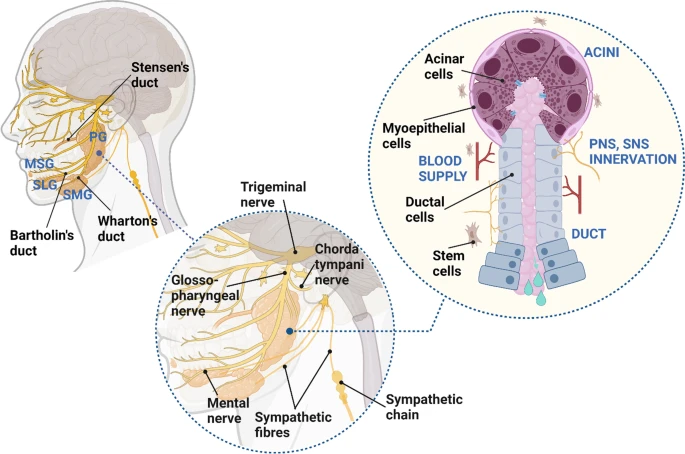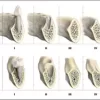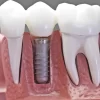Saliva compositions
A review of saliva: Normal composition, flow, and function
Humphrey.2001

- The average daily flow of whole saliva varies in health between 1 and 1.5 L day – 0.1 mL/min
- Saliva is 99% water.
- 20% from parotid, 65% from submandibular, 7% to 8% from sublingual, and less than 10% from numerous minor glands.
- The parotid contributing more than 50% of total salivary secretions.
- Types of cells found in the salivary glands
- Acinar cells : In which saliva is first secreted, determine the type of secretion produced from the different glands.
- Various duct system cells
- Intercalated: connecting acinar secretions to the rest of the gland.
- Striated: functioning as electrolyte regulation in resorbing sodium.
- Excretory: contribute by continuing sodium resorption and secreting potassium.
- Myoepithelial cells: long cell processes wrapped around acinar cells, contract on stimulation to constrict the acinar. Secreting or “squeezing out” accumulating fluid, is the result of a purely neural process.
- Secretion can be classified as serous, mucous, or mixed
- Parotid: Serous secretions
- Minor glands: mucous secretions
- Sub L, M : Mixed serous and mucous secretions
- Saliva is composed of a variety of electrolytes, including sodium, potassium, calcium, magnesium, bicarbonate, and phosphates.
- Bicarbonates, phosphates, and urea act to modulate pH and the buffering capacity of saliva
- Macromolecule proteins and mucins serve to cleanse.
- Calcium, phosphate, and proteins work together as an antisolubility factor and modulate demineralization and remineralization.
- Immunoglobulins, proteins, and enzymes provide antibacterial action.
- The normal pH of saliva is 6 to 7, meaning that it is slightly acidic.
- Salivary flow during sleep is nearly zero.
- Circannual (yearly) low flow occurs during the summer, whereas peak flow is during the winter
- Salivary highways and byways
- Salivary byways are areas in which acid by-products may remain in longer contact with oral structures unless mechanical means of cleansing are used
- The use of sugarless chewing gum or candy containing xylitol or sorbitol can be recommended as a means of stimulating extra salivary
- Function of salivary gland:
- lubrication and protection
- buffering action and clearance
- maintenance of tooth integrity : By maintaining the PH at normal. Resulting crystalline dissolution occurs at a pH of 5 to 5.5, which is the critical pH range for the development of caries.
- antibacterial activity
- taste and digestion : Salivary enzymes also initiate fat digestion.
- Bicarbonate is the most important buffering system.
- The pH then falls to its lowest level, to 6.1 or lower, approximately 15 minutes after food consumption.
- Research has shown that the use of gum containing xylitol or sorbitol reduces plaque accumulation and gingival inflammation and enhances remineralization potential
- The presence of fluoride in saliva speeds up crystal precipitation, forming a fluorapatite-like coating more resistant to caries than the original tooth structure.



